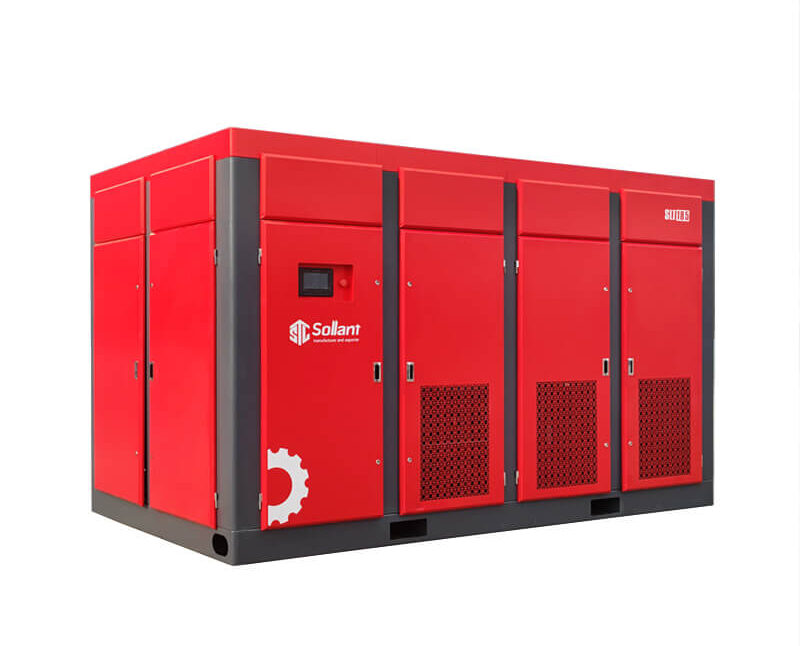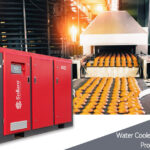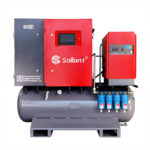1. Four basic marking methods
(1) Expressed by motor horsepower
This worked well when the air compressor technology was undeveloped in the early days, but with the continuous development of technology, even if the same motor is used now, the actual pressure will be different due to the pressure level, the air compressor manufacturer and the size of the model. The amount of air discharged by the air compressor is very different. Therefore, it is the most irresponsible practice to only indicate the horsepower of the motor on the catalogue.
(2) Expressed by Piston displacement
Since this is the design information of the air compressor, you only need to multiply the cylinder size by the number of revolutions, so this information is the easiest to obtain, and it is also used by many manufacturers for marking. There is no certain relationship between this theoretical value and the actual air output, depending on the technical capabilities of the manufacturer.
(3) Expressed by the Inlet volume
This method of expression is usually measured with an Orifice meter on the air inlet side, and is currently only used to indicate the size of the centrifugal air compressor. The unit used is ICFM. Although it is more accurate than the previous two methods, it is still higher than the actual gas output because the internal loss is not included.
(4) Expressed by Free air delivery
This method is measured on the outlet side by using an aperture flowmeter. Because of its accuracy, it has become the main standard in the world to measure the actual air volume of the air compressor, such as ISO, ASME, JIS, etc. However, in some Japanese manufacturers’ catalogs, Use F.A.D. to mark, but add Nominal capacity, it is generally understandable to say that this F.A.D. is not real, but just a design value.
It is a pity that it is one thing to have a standard, but another thing to have it done. Therefore, unless the standard on which the original factory catalog is based is stated in black and white, its credibility will be greatly reduced.
2. The actual air output volume indicated under different working conditions The actual air output volume refers to the air output volume measured at the outlet of the air compressor (after the aftercooler) considering all losses, usually in terms of free air output (Free Air Delivery) to indicate.
The so-called free air output refers to the volume of air compressed by the compressor expressed by the free air condition (temperature, pressure, humidity, etc.) at the air inlet.
Therefore, even if the same test standard is used, the displayed numbers will differ by more than 20% due to the different “free air” used. The following are several commonly used free air conditions.
(1) Normal Condition:
Expressed method: Nm3/min (or indicate the air intake conditions used in the test)
Indicated air condition: 760 mmHg, 0 0C, 0% RH
Volume Index: 1.00
(2) Standard Condition:
Representation method: SCFM (or indicate the air intake condition used in the test)
Air conditions referred to: 1 bar, 20 0C, 0% RH
Volume Index: 1.05 (approx.)
(3) Actual Condition:
Representation method: ACFM, ICFM (or indicate the air intake condition used in the test)
Air conditions referred to: 14.4 psi, 35 0C, 60% RH
Volume Index: 1.20 (approx.)
With the same air output, as long as different air conditions are used, the number can be increased by 20%.
3. The actual air volume tested under different pressures
The value of the actual air output (FAD) is related to the reference air condition, and also related to the test pressure.
For oil-injected screw air compressors, if the same actual air volume is to be maintained when the pressure rises, it is necessary to increase the rotor speed and consume 6-7% more motor power. For a completely oil-free screw air compressor, it needs to increase power consumption by about 10%.
For example, assume that a 55 kW micro-oil screw machine A measures the actual air volume of 9.54 m3/min at 7 barg, and another 55 kW micro-oil screw machine B measures the actual air volume of 9.1 m3 at 8 bar /min, is A more efficient or B more efficient?
According to the empirical formula above, if A wants to maintain the same air volume of 9.54 m3/min at 8 barg, it needs to increase the power consumption by more than 6%, namely:
55kW×1.06=58.3kW
The ratios of the two are:
A: 58.3kW÷9.54m3/min=6.11kW/(m3/min)
B: 55kW÷9.1 m3/min=6.04kW/(m3/min)
(6.11-6.04) ÷ 6.04×100%=1.16%
This means that the efficiency of B air compressor is 1.16% higher.
4. The motor power of the air compressor
The efficiency of the air compressor is related to the actual air output of the air compressor and the power consumed by the motor. The actual air volume will vary greatly in value due to different test methods and representation methods. There is also a similar situation when examining the motor power of the air compressor. At the same time, the efficiency of the air compressor is also related to the motor service factor and motor efficiency.
(1) Shaft horsepower at specific pressure
People often measure the efficiency of the air compressor by specific energy—the power consumption per unit of air output. The power consumption here refers to the shaft horsepower of a specific pressure, which means that when the outlet pressure of the air compressor reaches a certain pressure point, the air pressure The power consumed by the machine spindle. Due to the different pressure points selected by different manufacturers, the marked shaft horsepower values are also different.
(2) Service Factor
The motor power of the air compressor refers to the nominal horsepower or rated power of the motor, but this is not equal to the actual power consumed by the motor. For manufacturers in Europe and China, the actual power consumption of the motor is generally less than the rated power on the famous brand, while American manufacturers are used to using smaller motors with a larger service factor, such as 1.25, and at full load , The output of the motor can exceed 15% of the nameplate, such as a motor marked as 100HP, its actual output may exceed 115HP. This makes “the old rule that the actual power consumption of the motor must be less than the rated power on the motor nameplate is broken”.
Therefore, generally speaking, for air compressors with the same horsepower, the air volume data of European brands is smaller than that of American brands, for the above reasons. Now some European brand manufacturers have started the American approach.
5. Efficiency of the air compressor
As mentioned above, when considering the efficiency of the air compressor, it is necessary to consider its test method, indicating state, test pressure point, actual power consumption, etc. At the same time, it is also necessary to consider the motor efficiency, because the shaft horsepower is only the output part of the motor, and the user pays the electricity fee according to the input power. For calculation, the efficiency of the air compressor cannot be ignored without considering the efficiency of the motor.
In this way, if you don’t know the standards adopted by each manufacturer when labeling air compressors and selecting motors, it is almost meaningless to compare their efficiency based on the information in their catalogs. In fact, even with all the details of the various manufacturers, it is very difficult to compare, because the relationship between different standards is difficult to determine.
Therefore, comparisons made on the basis of the information provided in the catalog can only be “guided”.
Sollant Focus on Energy Saving



